Byzantine Fort City of Mystras, Greece

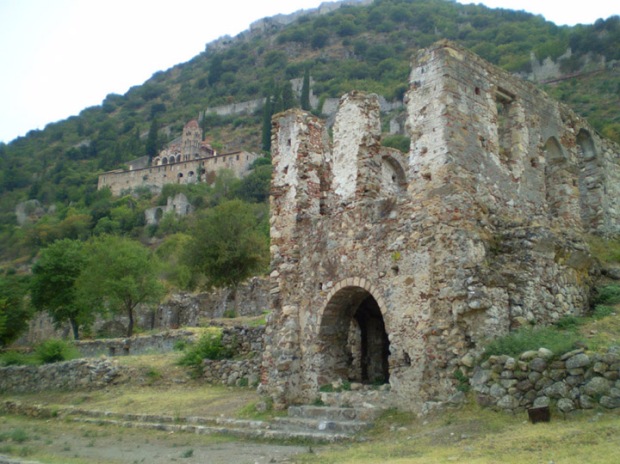
Looking up from the ruined domestic buildings of the lower city, you can see the active Monastery of Pantanassa further up the mountain in the the Upper City of Mystras, Greece.
So many European cities are jumbles of art and architecture, a testament to the evolving history of the urban area. Beneath these modern cities are fractured layers of a Renaissance, Gothic and Ancient past, but you have to try hard to imagine how things looked during any one period. It’s truly amazing to find a city that retains its character from one specific age. The abandoned Byzantine city of Mystras in the mountains just above Sparta in the Southern Peloponnese, is one such frozen city. You can walk through the ruined streets and largely intact religious buildings of this UNESCO World Heritage Site and be right back in 1350 AD.

Mystras is built on the side of a mountain topped with a sturdy and imposing Castle. Parts of the city walls are still visible.
Mystras began in 1249 with the construction of the Castle on the summit of Mt. Taygetos by the Frankish ruler William II Villehardounin. The Byzantine city grew as it consolidated local power through the 13th and 14th century. The walled city contained several religious communities and churches, domestic and commercial areas and a large palace for the regional lord. After the fall of Constantinople, Mystras was absorbed into the Turkish empire in 1460 and was then traded several more times between the Venetians, Turks and Greeks. The city remained inhabited until the 1826 when it was abandoned for the more accessible, modern city of Sparta.

Partial view from the path to the Upper city of Mystras Lower City and the Metropolis (or cathedral) begun in the 13th century.
Below the Castle on Mt. Taygetos, the ruins of Mystras are divided into an Upper City and Lower City. The churches are Byzantine in design but constructed with a mix of stone blocks, stone pieces and brick enhancing the rustic look of the ruined city. The architecture is quite sophisticated; the Metropolis (cathedral) is three stories tall with upper viewing galleries. The churches have elegant domes, arches and are all unique in design which is surprising given the density of religious buildings.
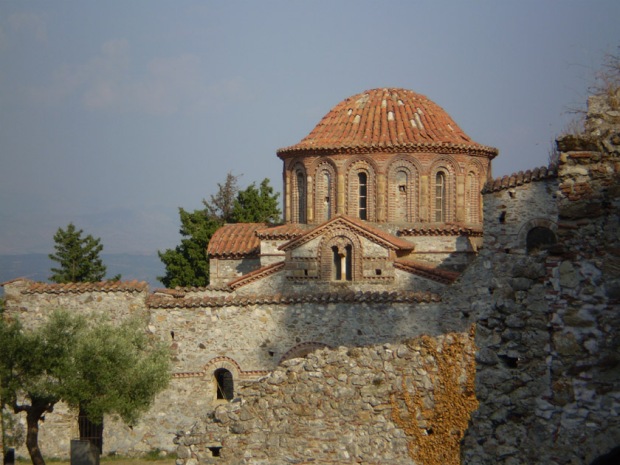
The architecture of the Lower Town is enriched by the impressive dome of the Church of Saints Theodore (Ayioi Theodoroi) who were two military martyrs greatly admired in Byzantine Greece.
Several of the churches and monasteries still contain brightly painted frescoes. The most impressive paintings are in the Hodegetria showing detailed scenes from the Life of Christ throughout the side aisles. Some interior marble paneling survives suggesting the church was richly decorated when constructed.
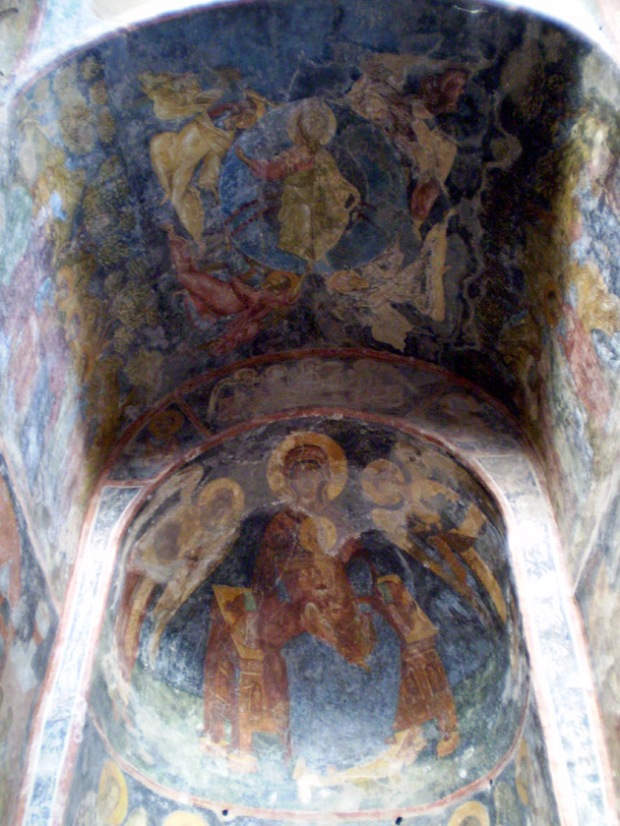
Though damaged, the frescoes of the Peribleptos sanctuary depict the Virgin, Divine Liturgy, Communion of the Apostles and the Ascension.
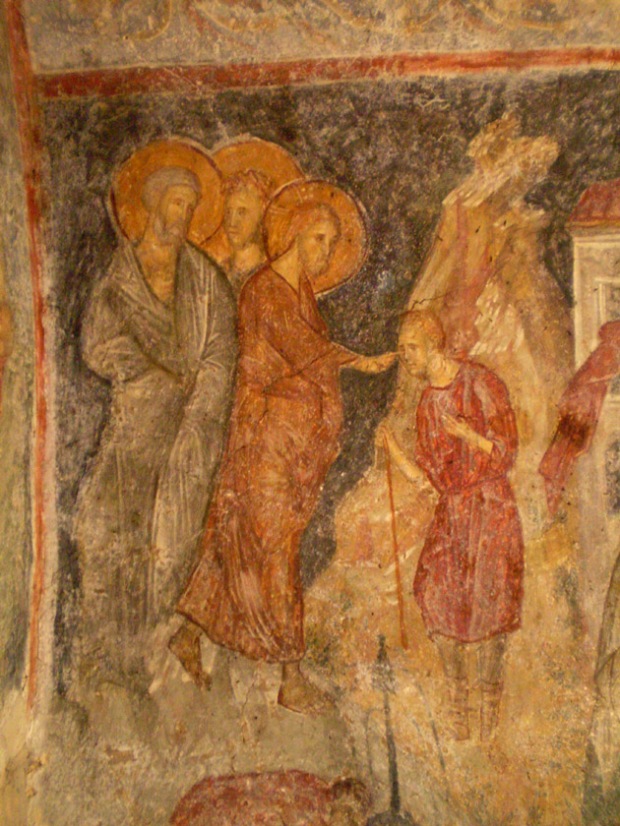
Looking somewhat like a pastel drawing, this fresco in the Hodegetria narthex show the healing of the blind man.
Visiting Mystras is an exhausting day trip but well worth the effort. Since you must either park below the Lower Town or just below the Castle, you will be walking a lot to see the entire city! In addition to the impressive painted churches, there are numerous small churches and manor houses in the Lower Town that deserve slow exploration. It’s also fun to visit the nuns and their cats who live in an active convent in the Upper City (the Monastery of Pantanassa). Lastly the views of Sparta and the valley from the Castle are incredible.
Given the size of the archaeological site, it is very possible to find yourself alone in this well preserved Byzantine city imagining daily life within this rugged, fortified mountain city buoyed on by its exquisite churches.
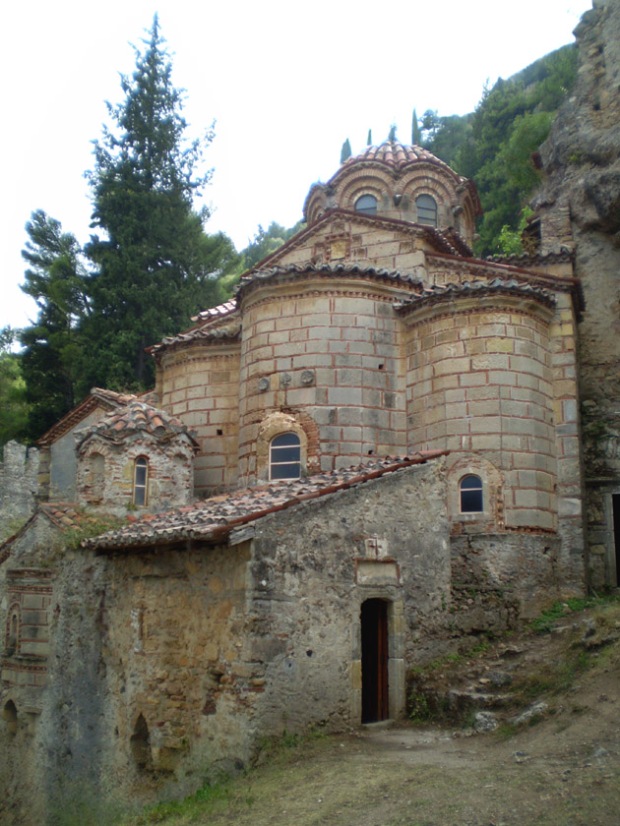
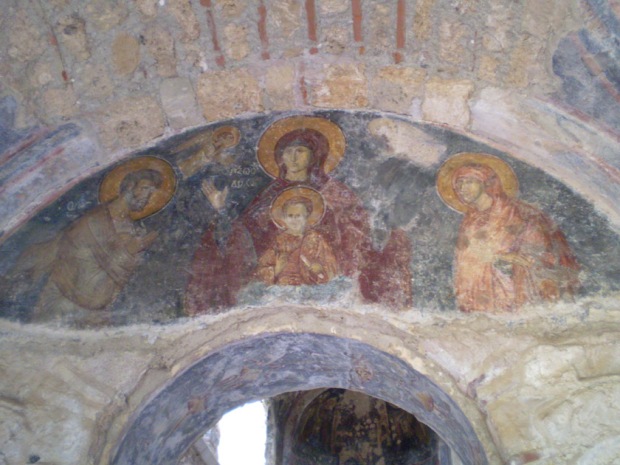






Reblogged this on Art History Ramblings.
LikeLike
Such a cool spot to visit. I’ve never heard of this place before but it looks like a great spot to visit to get away from the crowds and get a more intimate experience with history.
LikeLike
Absolutely! There is a lot of amazing history in mainland Greece. Sometimes I think the islands get all the press. (But they are quite beautiful, so maybe it’s deserved… 🙂 )
Happy I could share this place with you!
LikeLike
I had the good fortune of visiting Mystras 17 years ago. I remember the climb being very arduous and the heat intense, but as you say, well worth the effort. It is a powerful memory that lingers in my mind and I very much enjoyed seeing your photos to take me back again. I hope to be able to visit there again some day.
LikeLike
Thanks for mentioning the climb Kerri. Mystras certainly is a mountain city so visitors do need a sufficient level of fitness to get around. But you can go slow and as I found, they do sell ice cream and cold drinks in the lower town parking lot. 🙂
I’m glad you got to experience Mystras and am happy to hear my photos brought you back. I hope you are able to return soon!
LikeLike